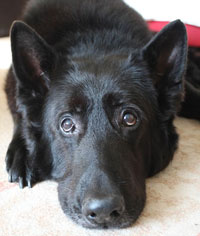| Back to Back Issues Page |
 |
|
Shepherd Guide, Issue #016 -- Sep 11 September 30, 2011 |
Welcome to another issue of the Shepherd Guide! Thank you for subscribing. As always, in respect for your time, I will keep these updates short and to the point. Special note: Looking for a GSD? Please consult a German Shepherd Rescue. There are many deserving GSDs looking for their forever home. September 2011 In this Issue:
1. In The News
They are currently being housed by the German Shepherd Dog Rescue in the UK. Hard to believe that these beautiful, talented, animals are now in a foster home awaiting their forever homes. Have they lived past their earning potential? Owner, Paul Thompson said, "I found myself spending a lot of time away from home. The dogs needed more attention then I could give. It was a difficult decision to make but one I had to accept was best for the dogs." I truly hope these two can be adopted together into a loving home that will offer the respect and dignity they deserve in their golden years. Have something incredible to share about your dog? How about telling us what makes your dog unique? Share your dog stories here. Read more stories about German Shepherds in the news. 2. GSD Hero of the Month Canine Heroes of 9/11 In the aftermath of 9.11.01, over 350 dogs and their handlers went to work in New York City and Washington, D.C., searching for survivors and recovering remains. These canine heroes, from all over the US (including Puerto Rico), Canada and Europe, included:
Many breeds contributed to this life-saving effort, including Border Collies, German Shepherds, Golden Retrievers, Laboratort Retrievers, Rottweilers, Spaniels, mixed breeds, a Doberman and even a few Dachshunds. These heroes worked tirelessly in 12-16 hour shifts, scorching their paws in hot debris and rubble while maneuvering through heavy smoke and fumes. The effects of this grueling task were not only physical, but psychological as well. A veteran search and rescue German Shepherd dog found the bodies of two missing firefighters on his first day at Ground Zero. His handler said it overwhelmed him. The dog lay down and curled up on the spot of the find. Shortly afterwards, he began shedding uncontrollably and refused to eat or interact with other dogs. He was retired from duty shortly thereafter. Another dog lost 12 pounds in just 11 days. Search and rescue dogs are trained to find survivors. After several days of finding none, they can quickly lose morale. The handlers resorted to staging mock finds to raise the spirits of the hardworking dogs. The mere presence of the dogs served to comfort and boost the spirit of the humans working in the effort. According to an unidentified handler, "These dogs have been trained to pick up on trauma and go towards it. So they pursue people they perceive as being in a state of trauma ... We've been visiting a lot of firemen, police, and cleanup detail." Everyone who worked 'the pile' will agree that the dogs' presence was not only important for search and rescue, but for emotional health as well. Terri Crisp, Director of the Emergency Animal Rescue Service in 2001, said: "There were two things, the handler told us, that really yanked on his emotions—a small doll pulled from the debris and the gift he and Ranger [his dog] had received from a child. The gift was a small Ziploc bag with two dog biscuits and two Hershey kisses inside, along with a note printed by the child that said, 'Lassie would be so proud of you.'" 10 years has passed since 9.11.01, and many of these dogs have passed on. But their spirits will forever live in the hearts and minds of a grateful nation. Tribute to Canine Heroes of 911 3. Training Many of you have asked about how to deal with aggressive dog behavior. There are many mindsets for dealing with this, and one that I have come to trust comes from Ed Frawley of Leerburg Kennels. Who is Ed Frawley and why should I believe him? His information is based on 45 years of experience training dogs. For the last 30 years Ed has studied the art of protection training dogs. He was a police K9 handler for 10 years, and was chairman of the training committee for the WI police dog association for a number of those years. He has bred German Shepherds for police service work for 28 years. During this time he bred over 350 litters of working dogs. Dogs from his kennel work in law enforcement, Search and Rescue and compete in Schutzhund all over the country. He has said, and I agree, that, "Opinions should be backed by experience." Over a five year span, he has developed a 3 1/2 hour video that will teach you how to deal with dominant and aggressive dogs. His site also contains many free resources on everything from housetraining to establishing pack structure structure with the family pet. After reading his material, I finally understand why my dog trainer said that the issues are not with my dog, but with me. We tend to forget that dogs are pack animals, and in order to have a mutually fulfilling relationship, we need to understand and embrace that. 4. Health Issue Is your dog an attention seeker or show signs of fear when exposed to loud noises? A study done just reported in Veterinary Record, the official journal of the British Veterinary Association shows evidence that puppies should not be separated from their mother and littermates too early. These issues and the following were studied:
Titled Prevalence of owner-reported behaviours in dogs separated from the litter at two different ages, the study involved 140 adult dogs. Half of them were removed from their litters at 30 - 40 days of age and the other half were taken from their litter at 60 days. 1/2 of the dogs were purchased at pet shops, 1/3 came from a friend or relative, and the rest were from breeders. The study found that early separation from the litter sets the stage for behavior problems in adult dogs. The period from 2 1/2 to 3 weeks through 12 to 14 weeks is considered the sensitive stage. During this period, puppies can generally accept new experiences with minimal fear. This shapes the adult character, temperament and behavior of your dog. Much of what is learned during the sensitive period results in stimulus-specific and long-lasting behavioural changes, potentially providing a foundation for many adult behaviour patterns and problems (Fox 1978, Godbout and others 2007), aversions, social responsiveness (Scott 1958), patterns of active and passive agonistic behaviour (Fox 1966), general activity levels (Wright 1983), reactions to separation (Pettijohn 1977), approach-avoidance patterns (Fox 1966), the development of social hierarchical relationships (Scott and Fuller 1965), anxiety (Ramos and Mills 2009) and functional fear responses (Melzack and Scott 1957). The research suggests that many social and behavioral problems that are seen in adult dogs are directly related to having been separated from their litter too early. During the socialisation period, puppies are normally exposed to novel environmental stimuli within the context of the guidance and reassuring presence of their dam. From about three weeks of age, puppies become extremely distressed if they are placed in a strange situation without their dam, littermates and nest sites (Elliot and Scott 1961). Dogs separated early from their litterare much more likely to show avoidance and fearful behaviors. Specifically, they are:
Puppies should not be separated from their mother and litter until they are at least 8 weeks old. Schatzi was 7 1/2 weeks old when I got her and I now have a better understanding of where some of her behavioral issues come from. 5. What's On Your Mind? As a fellow German Shepherd lover, I want to hear what you may have questions or concerns about. What would you like to read about in future issues? Reply to this email and let me know. Until next time, If you like this newsletter, tell a friend. |
| Back to Back Issues Page |
 10 year old Berry, best known for his role as Padfoot in the famous Harry Potter series is seeking a new home.
10 year old Berry, best known for his role as Padfoot in the famous Harry Potter series is seeking a new home. Berry played the animagos for Gary Oldman's character, Sirius Black in the blockbuster film series. Berry's best buddy, a 13 year old German Shepherd mix named Porridge, also a screen star, is seeking a new home as well.
Berry played the animagos for Gary Oldman's character, Sirius Black in the blockbuster film series. Berry's best buddy, a 13 year old German Shepherd mix named Porridge, also a screen star, is seeking a new home as well.